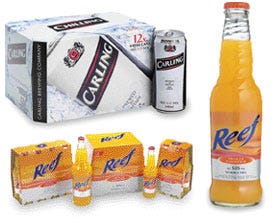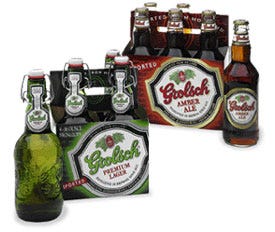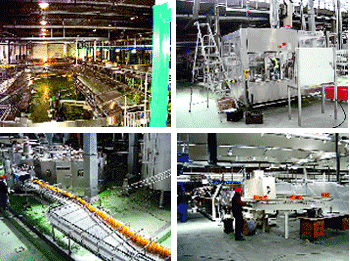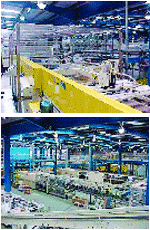Coors works its magic during plant consolidation
January 29, 2014

The most ambitious undertaking in Coors Brewers Ltd.'s long history was called Project Merlin, and the choice of title is quickly apparent. In late 2001, the separation of Coors from Interbrew resulted in the transfer of approximately 1 million barrels of export production to Interbrew, 700,000 of that from Coors' Cape Hill, U.K., operation. Left with two plants in England–one of them now virtually defunct, the other in Burton still viable–the brewer was faced with a critical strategic decision: Transfer the Cape Hill lines to Burton at a minimum initial capital cost, or take a once-in-a-lifetime opportunity to rebuild the Burton site into a state-of-the-art facility?
The first option was referred to as Base Case scenario, the latter as Desired Future State. The decision by Coors to follow its dreams was finalized in March, 2002, and Project Merlin quickly came to life. The directives were clear: maximize revenue savings, provide for future growth potential, maintain production capacity, and set new production targets at finalization.
The engineering challenge was steep, but so was the personnel issue of moving current staff during the transition. Although the physical work began in June, 2002, Cape Hill's bottling and canning lines did not close down or move until the very end of the year. The plan was to build three canning lines in one hall, three bottling lines in a second hall, and three keg lines in yet a third plant. Most of the building/rebuilding at Burton needed to be accomplished during January through March, 2003, when demand was at its lowest. This was successfully achieved, and the last relocated line began production on June 23. By the time of PD's visit in late September, everything appeared to be up and running on cue.
Says David Wiggin, Coor's director of packaging innovation, "We planned a packaging platform for the future. This was our strategic direction. It was incredibly intensive." Supply chain director Martin Thomas, concurs: "We had to reinvent the packaging operations as we went, continuing to generate output. It's as if we decided to set the table whilst we ate lunch."
Plant manager and project leader Peter Orgill explains that the Base Case scenario would probably have cost only ?8 million to ?10 million. "But it would probably not be able to be further expanded later. This was a once-in-a-lifetime opportunity to develop Burton to our future strategic vision.
|
In the bottling hall, empty bottles move through enclosed conveyors to protect them against damage, left top. Bottles then convey to the filler, left bottom, and labeler, right top. Finally, filled and labeled bottles head to the wraparound case packer, right bottom. |
"It was a nightmare to implement," Orgill continues. "We disrupted everything. But once we started, we had to finish it all. We challenged ourselves to improve output. We kept pushing and pushing for better design." Was it worth the effort? During this past unprecedented summer, the plant operated at 25 percent above its target production.
The Burton plant produces Carling, Worthington's and Grolsch beers, Coors Fine Lite beer and Reef flavored alcoholic beverage in bottles.
The canning line
On one of the three lines, 202 cans from Ball (sourced locally) arrive 5,800 per pallet. The Busse depalletizer includes a dunnage-handling system for automatic removal of top frames, layer pads and pallets. The machines can depalletize 2,500 cans/min. The conveyors need to handle 2,000 cpm to feed the filler. The wide conveyors allow the cans to move slowly to alleviate damage to the empty cans and to minimize fallen cans.
|
In the canning hall, empty cans are depalletized, top, and filled cans are case-packed, above. |
A vacuum-transfer unit discards any damaged or fallen cans. As they convey to the filler, cans are rotated upside down so that deionized air from a Ling rinser can blow out any debris or dust. Meanwhile, beer is transferred from the Bright Beer Storage Tanks and enters the inlet buffer tanks just prior to the filler. The 165-head Krones filler can handle fills at 2,000 cpm. Can lids arrive in paper tubes, which are fed into a hopper on a CSW machine, and the paper is stripped away. The cans are seamed on Angelus machinery. A valve-by-valve fill check is accomplished by Heuft equipment. Filled cans then convey to the Sander Hansen pasteurizer, where they remain on one of two decks for about 40 min.
After exiting the pasteurizer, air is blown onto the cans to dry them. The fill height is checked via x-ray inspection from Heuft, and any under-filled cans are rejected. A Videojet coder then applies the best before date onto the can bottom. Cans now convey to packing.
Four-packs are assembled on Hi-Cone equipment, and the cans sort to one of five Riverwood multipackers. The cans are packed in 10-, 12-, 15-, 18- and 24-packs. A twin-stack packer from Riverwood  is available but currently not used. A tray wrapper from Kisters is also used in some multipacks. At the time of PD's visit, canning line #3 was running 500-mL cans for Worthington's, with a widget inside. The lines in the canning hall are organized so that cans from any of the three filling lines can feed to any of the five multipackers or the sleeve packer, and any of the multipackers can feed to any of the five palletizers.
is available but currently not used. A tray wrapper from Kisters is also used in some multipacks. At the time of PD's visit, canning line #3 was running 500-mL cans for Worthington's, with a widget inside. The lines in the canning hall are organized so that cans from any of the three filling lines can feed to any of the five multipackers or the sleeve packer, and any of the multipackers can feed to any of the five palletizers.
The bottling hall
The bottling operation, led by manager Gordon Smith, starts with a bulk glass depalletizer from KHS, feeding to a Krones Toptronic empty bottle inspection system. The Krones fillers, one operating at 750 bottles/min and the other at 650 bpm, follow.  Bottles are from United Glass, Quinn Glass, Rockware Glass and Rexham. Crowns are sourced through Pelliconi Group. All bottles receive glue-applied paper labels (sourced locally) on Krones Topmatic or Solomatic labelers, although Smith says that pressure-sensitive labelers may be added later. Line #1 currently has two labelers so that the filler can be upgraded to 1,000 bpm (it's rated up to 1,400). Conveyors from Gebo and ASI move bottles through the lines to multipacking on Riverwood equipment. Alvey palletizers complete the operation.
Bottles are from United Glass, Quinn Glass, Rockware Glass and Rexham. Crowns are sourced through Pelliconi Group. All bottles receive glue-applied paper labels (sourced locally) on Krones Topmatic or Solomatic labelers, although Smith says that pressure-sensitive labelers may be added later. Line #1 currently has two labelers so that the filler can be upgraded to 1,000 bpm (it's rated up to 1,400). Conveyors from Gebo and ASI move bottles through the lines to multipacking on Riverwood equipment. Alvey palletizers complete the operation.
More information is available:
Canning lines:Depalletizer: Busse/SJI, Div. of Arrowhead Systems, 920/326-3131. www.arrowheadsystems.com. Circle No. 232.
Can conveyors: Sidel Packaging Systems Div., 941/727-1400. www.sidel.com. Circle No. 233.
Cans: Ball Corp., 303/460-5010. www.ball.com. Circle No. 234.
Rinser: Ling Systems Ltd., 44 (0)1480 216666. www.ling.co.uk/flash/flashed.htm. Circle No. 235.
Lid feeder: R.A. Jones & Co., Inc., 859/341-0400. www.rajones.com. Circle No. 236.
Filler: Krones, Inc., 414/409-4000. www.krones.com. Circle No. 237.
Seamer: Angelus Sanitary Can Machine Co., 323/583-2171. www.angelusmachine.com. Circle No. 238.
Pasteurizer: Sander Hansen, A/S, 45 43 46 61 00. www.krones.de/sander-hansen/ Circle No. 239.
Can inspection: Heuft USA, Inc., 630/968-9011. www.heuft.com. Circle No. 240.
Ink-jet coders: Videojet Technologies, Inc., 630/860-7300. www.videojet.com. Circle No. 241.
Can rings: ITW Hi-Cone, 630/773-9300. www.hi-cone.com. Circle No. 242.
Multipacker: Riverwood Intl. Holding, Inc., 770/644-3000. www.riverwood.com. Circle No. 243.
Tray packer/film overwrapper: Kisters Kayat, Inc., 386/424-0101. www.kkiusa.com. Circle No. 244.
Palletizer: Alvey Systems, Inc., 314/993-4700. www.alvey.com. Circle No. 245.
Bottling lines: Bulk glass depalletizer: KHS-Bartelt, Inc., 941/359-4000. www.bartelt.com. Circle No. 246.
Bottles: Rexam Plc, 44 20 7227 4100. www.rexam.com. Circle No. 247.
Bottle conveyors: Sidel Packaging Systems Div., 941/727-1400. www.sidel.com. Circle No. 248.
Filler, labeler: Krones, Inc., 414/409-4000. www.krones.com. Circle No. 249.
PLCs: Allen-Bradley, 414/382-2000. www.rockwellautomation.com. Circle No. 250.
Palletizer: Alvey Systems, Inc., 314/993-4700. www.alvey.com. Circle No. 251.
Coors: Tracing a long history |
Coors Brewer's Ltd.'s U.S. parent company, The Coors Brewing Company, was founded in 1873 by Adolph Coors, a German immigrant who opened The Golden Brewery in Colorado. Drawn to the location by the purity of its spring water, Coors was making a profit within 12 months and producing 17,600 barrels per year by 1890. |
About the Author(s)
You May Also Like




